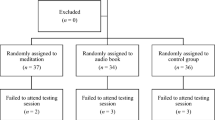Abstract
The purpose of this study was to determine whether the frontal muscles of the forehead during the imagination of an individualized stress situation reflect general arousal. Physiological arousal and subjective feelings of tension were measured during a stress and a relaxing imaginative situation, utilizing a counterbalanced design. Frontalis EMG during stress imagination was raised and was paralleled by more reported tension, elevated skin conductance, and trends toward increments in heart rate and respiration rate. The raised frontalis EMG can be seen as a consequence of the greater effort spent in the stress imaginative situation than in the relaxing one. This experiment supports an important assumption of the clinical application of frontalis EMG biofeedback to stress-related disorders. Other assumptions still remain to be examined.
Similar content being viewed by others
References
Alexander, A. B. An experimental test of assumptions relating to the use of electromyographic biofeedback as a general relaxation training technique.Psychophysiology 1975,12 656–662.
Alexander, A. B., French, C. A., & Goodman, N. J. A comparison of auditory and visual feedback in biofeedback assisted muscular relaxation training.Psychophysiology 1975,12 119–123.
Budzynski, T. H. Biofeedback procedures in the clinic.Seminars in Psychiatry 1973,5 537–547.
Budzynski, T. H., & Stoyva, J. Biofeedback techniques in behavior therapy. In N. Birbaumer (Ed.),Neuropsychologie der Angst. Munich: Urban & Schwarzenberg, 1973.
Burish, T. G., & Horn, P. W. An evaluation of frontal EMG as an index of general arousal.Behavior Therapy 1979,10 137–147.
Fridlund, A. J., Fowler, S. C., & Pritchard, D. A. Striate muscle tensional patterning in frontalis EMG biofeedback.Psychophysiology 1979,16 203.
Gatchell, R. J., Korman, M., Weis, C. B., Smith, D., & Clarke, L. A multiple-response evaluation of EMG biofeedback performance during training and stress induction conditions.Psychophysiology 1978,15 253–258.
Glaus, K. D., & Kotses, H. Generalization of conditioned frontalis tension: A closer look.Biofeedback and Self-Regulation 1978,3 200.
Haynes, S. N., Moseley, D., & McGowan, W. T. Relaxation training and biofeedback in the reduction of frontalis muscle tension.Psychophysiology 1975,12 547–552.
Lacey, J. I., Kagan, J., Lacey, B. C., & Moss, H. A. The visceral level: Situational determinants and behavioral correlates of autonomic response patterns. In P. H. Knapp (Ed.),Expression of the emotions in man. New York: International Universities Press, 1963.
Ohno, Y., Tanaka, Y., Takeya, T., & Matsubara, H. Biofeedback modification of frontal EMG in normal subjects.Biofeedback and Self-Regulation 1978,3 61–68.
Reinking, R. H., & Kohl, M. L. Effects of various forms of relaxation training on physiological and self-report measures of relaxation.Journal of Consulting and Clinical Psychology 1975,43 595–600.
Shedivy, D. I., & Kleinman, K. M. Lack of correlation between frontalis EMG and either neck EMG or verbal ratings of tension.Psychophysiology 1977,14 182–186.
Sime, W. E., & DeGood, D. E. Effect of EMG biofeedback and progressive muscle relaxation training on awareness of frontalis muscle tension.Psychophysiology 1977,14 522–530.
Stoyva, J., & Budzynski, T. Cultivated low arousal—An anti-stress response? In L. V. DiCara (Ed.),Limbic and autonomic nervous system research. New York: Plenum, 1974.
Author information
Authors and Affiliations
Rights and permissions
About this article
Cite this article
Passchier, J., v. d. Helm-Hylkema, H. The effect of stress imagery on arousal and its implications for biofeedback of the frontalis muscles. Biofeedback and Self-Regulation 6, 295–303 (1981). https://doi.org/10.1007/BF01000655
Issue Date:
DOI: https://doi.org/10.1007/BF01000655




